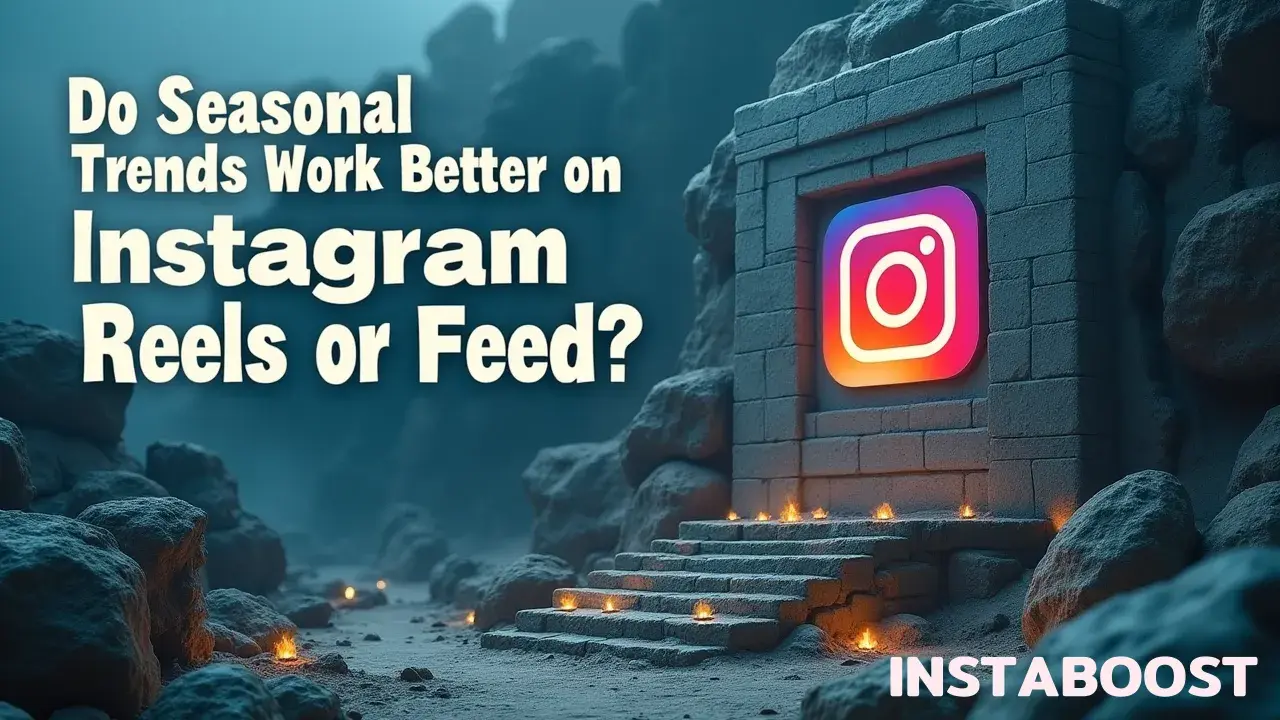Do Seasonal Trends Work Better on Instagram Reels or Feed?
Seasonal trends typically gain more traction on Instagram Reels due to short-form discovery and algorithmic reach. Reels can surface timely content to broader audiences, while Feed posts may deepen engagement with followers when the trend aligns with established visuals. Results hinge on timing, format relevance, and how well the content maps to seasonal intent. A smart path pairs trend-focused Reels for reach with complementary Feed posts for context and consistency.
Decoding the Seasonal Surge: Where Does Trendy Content Shine on Instagram?
Seasonal trends – like gearing up for the holidays, sharing summer getaway tips, or looking back at the year – have become pretty central for anyone trying to get more traction on Instagram. But since Instagram gives you both Feed posts and Reels to work with, choosing where to put those ideas isn’t always straightforward. There are moments when Reels, with their quick edits and upbeat energy, seem like the obvious choice, especially if you want your content to hop onto a trending sound or a popular challenge. Other times, a traditional Feed post might make more sense – maybe you want to write a longer caption, share a carousel of photos from a winter trip, or just create something that feels a bit more permanent.
The thing is, Instagram’s algorithm handles each type differently, and what people are hoping to see can change – sometimes by the season, sometimes just as habits shift. So making these decisions isn’t only about chasing what’s trending; it’s more about thinking through things like timing, how you want your post to look and feel, and how people are actually going to come across it. In a feed that always feels busy, it seems like the creators and brands who really pay attention to the little differences between Feed posts and Reels – and try to match their seasonal content to what fits best – tend to do better, whether that means more people liking and saving a post or maybe seeing a few new faces show up in the comments.
Even the subtle differences in how you edit your profile or adjust your presentation can matter – a reason so many people spend time exploring Instagram profile enhancers alongside their posting strategy. When you’re deciding between the two, there isn’t a single answer that works every time. It comes down to watching what actually connects, and being willing to switch things up as you go.

Rethinking What “Works” on Instagram: Beyond the Numbers
Lately, I’ve started to see that our so-called “success metrics” are really about managing our nerves more than anything else. For a long time, it felt normal to track things like likes, reach, or new followers, especially when trying to compare how Reels perform against Feed posts during busy seasons. It all looks very tidy in a spreadsheet, but I’m not sure those numbers tell the whole story.
With Reels, say you use a popular holiday meme or a trending sound – your view count might shoot up overnight. It feels good in the moment, but those numbers can fade as quickly as they came. Feed posts act a bit differently. When people take the time to comment, save a post, or return to it later – like when someone scrolls back to your holiday gift guide a week after you shared it – that kind of response feels more substantial, even if the numbers aren’t as flashy.
So, are Reels or Feed posts better for seasonal campaigns? I don’t think it’s that simple. It usually depends on things like how the algorithm is working that week, what your audience wants right now, and whether a trend sticks around long enough to matter. Sometimes I’ll even notice people looking up tips on how to grow your Instagram audience just to get a sense of what’s possible, but it’s still worth thinking about what we actually want from all this: are we after fast reactions, or something that lasts a bit longer? I’ve noticed brands like INSTABOOST are starting to pay more attention to what actually pushes people to do something, instead of getting stuck on which format “wins.” When I look at our reports now, I keep asking myself if we’re measuring the things that really matter, or just the ones that are easiest to count.
Adapting Strategy to Instagram’s Real-World Dynamics
Strategy, when it comes down to it, is about noticing what’s happening and making adjustments as you go. It’s straightforward enough to plan out a calendar full of seasonal posts – maybe you set up some holiday photos for the Feed or line up a batch of Reels that fit the summer mood. But things rarely unfold exactly the way you expect on Instagram.
What ends up working is often about how quickly you can notice when something’s off and try a different approach. Sometimes you’ll find that a Feed post takes off when the moment for that trend has already passed, and other times a Reel will start getting traction right away, just because the algorithm is in your favor that day. The main thing is paying attention to what your audience is actually doing – if you see people sharing your holiday Reel with friends, or saving your Feed post to come back to, that’s information you can use. Oddly enough, even something like a like booster for Instagram can change the way a post picks up momentum and reveal what people are responding to.
Neither format is always the answer. Posts in the Feed are good for going deeper – maybe you can explain the story behind a holiday tradition, or share something people want to refer to later. Reels are more about acting quickly, like using a popular sound or visual before it feels old. The best way to handle seasonal posts isn’t about getting the format exactly right, but about staying open to what’s happening and being willing to switch things up. Brands that are comfortable trying both approaches and paying attention to what seems to resonate usually end up getting more out of seasonal trends, not because they’re chasing numbers, but because they’re learning, bit by bit, what actually draws people in.
Letting Go of Algorithm Entitlement
To be real, Instagram’s algorithm isn’t set up to reward your hard work just because you spent hours editing a Reel or found the perfect photo from your trip. I know it feels discouraging when something you put effort into doesn’t get noticed, but getting upset over it can make you lose sight of how things actually work there. The algorithm isn’t as simple as putting in good posts and getting guaranteed likes or comments back. It keeps shifting, based on what’s keeping people interested and coming back. If you try to follow every new trend or posting tip – especially when everyone’s rushing to post during busy seasons – it’s easy to end up frustrated when things don’t turn out as you hoped.
What I’ve seen is that people who do well on Instagram treat each part of it a bit differently. They’re willing to change their approach when they notice things are shifting, instead of sticking to what worked last year or last season. Past experience can help, like noticing that certain posts do better around the holidays, but relying on old strategies over and over just wears you down.
When your seasonal posts don’t take off, it usually helps to look at how your followers are actually responding – maybe you notice more conversations on your Feed in the fall, or see that people watch your Reels longer in the spring when they’re planning for something new. Sometimes it’s tempting to think there’s a shortcut or some reliable way to raise your view count, but what seems to matter most is paying attention and being willing to try something different, instead of expecting the algorithm to reward everyone the same way. When brands like INSTABOOST talk about staying ahead, I think what they really mean is not getting caught up in the idea that there’s a trick to it, but actually watching how people interact with what you share.
Seasonal Trends as an Invitation, Not a Formula
Honestly, there isn’t a straightforward answer about whether seasonal trends work better on Instagram Reels or in the main Feed. It really depends on how you approach each one, and what you want your followers to take from it. You can use a Reel to share something quick and light, like a behind-the-scenes look at your winter setup or a short clip of a new fall recipe, while a Feed post might give you space to go a bit deeper and share why that moment matters to you. Seasonal trends can help pull people in, especially if they’re already thinking about those topics, but the thing that actually keeps them interested is when your posts match your own style and point of view.
People notice when you’re only copying what’s popular, and if you rely on that, you start to lose what made your account interesting in the first place. Instead, it seems better to let these trends guide you toward something you might not have tried, or to share your own take, even if it’s a small detail that others overlook. If you’re tracking what works – maybe watching your analytics or using a tool like INSTABOOST – it helps to look for patterns in how your audience reacts when you put your own spin on things, and sometimes you’ll notice that authenticity goes hand-in-hand with stronger post performance.
The accounts that seem to stand out are the ones that take what’s trending and adjust it to fit their own pace, not the ones chasing every new idea. So when you’re deciding between Reels or the Feed, it’s probably more useful to see what fits naturally with what you want to share that day, and let yourself find out what actually connects, even if it’s not what you expected.
Experimentation Is the Only Reliable Strategy
To really understand whether Reels or Feed posts help you connect with people around seasonal trends, it’s probably best to start by paying close attention as you try things out. Instagram’s algorithm shifts, and what people respond to can change from year to year; something that went over well before might not get much traction this time. It helps to approach each seasonal campaign in a low-key, curious way – maybe you post a Reel with a current song and some light editing, then share a quiet carousel in your Feed, like step-by-step photos of how you organize a closet for spring or your go-to recipe for a holiday meal.
Watch which posts actually get people to comment or share, not just view quickly and scroll on. A high view count doesn’t always mean it meant something to someone. Sometimes, just seeing how a few thoughtful replies or reactions add life to your Instagram comment feed gives you a better sense of what resonates.
The point isn’t really to try to go viral, but to see which kinds of posts actually reflect who you are and what you want to share. Instagram’s analytics, and tools like INSTABOOST if you’re looking for more detail, can show you what’s connecting in each format. The people who seem to really know what works aren’t guessing – they’re looking at the small patterns, changing course, and quietly testing new things. Over time, you start to notice patterns – maybe Reels pick up in summer when people want quick, light ideas, and then in winter your followers spend more time with in-depth Feed posts, like a recipe or a thoughtful list. It takes a while to spot these things, and you only notice by letting yourself try both and seeing what happens.















